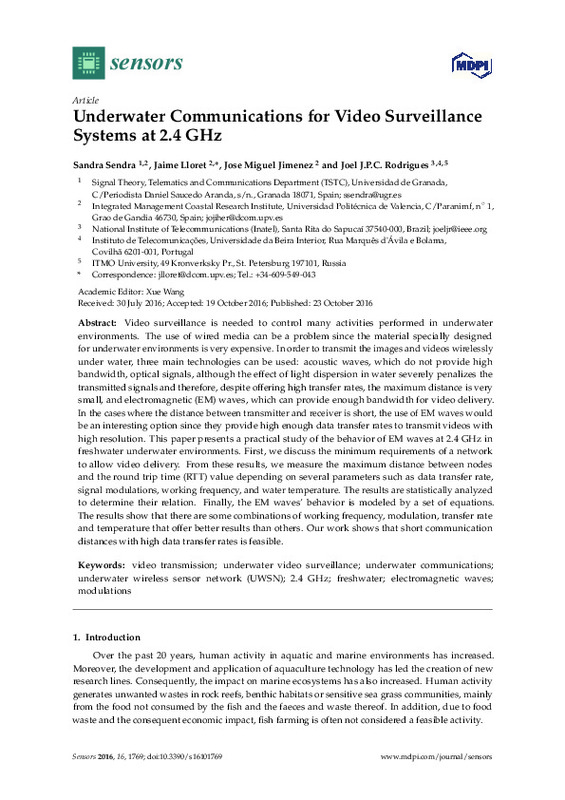JavaScript is disabled for your browser. Some features of this site may not work without it.
Buscar en RiuNet
Listar
Mi cuenta
Estadísticas
Ayuda RiuNet
Admin. UPV
Underwater communications for video surveillance systems at 2.4 GHz
Mostrar el registro sencillo del ítem
Ficheros en el ítem
| dc.contributor.author | Sendra, Sandra
|
es_ES |
| dc.contributor.author | Lloret, Jaime
|
es_ES |
| dc.contributor.author | Jimenez, Jose M.
|
es_ES |
| dc.contributor.author | Rodrigues, Joel José Puga Coelho
|
es_ES |
| dc.date.accessioned | 2017-06-08T14:45:13Z | |
| dc.date.available | 2017-06-08T14:45:13Z | |
| dc.date.issued | 2016-10 | |
| dc.identifier.issn | 1424-8220 | |
| dc.identifier.uri | http://hdl.handle.net/10251/82581 | |
| dc.description.abstract | Video surveillance is needed to control many activities performed in underwater environments. The use of wired media can be a problem since the material specially designed for underwater environments is very expensive. In order to transmit the images and videos wirelessly under water, three main technologies can be used: acoustic waves, which do not provide high bandwidth, optical signals, although the effect of light dispersion in water severely penalizes the transmitted signals and therefore, despite offering high transfer rates, the maximum distance is very small, and electromagnetic (EM) waves, which can provide enough bandwidth for video delivery. In the cases where the distance between transmitter and receiver is short, the use of EM waves would be an interesting option since they provide high enough data transfer rates to transmit videos with high resolution. This paper presents a practical study of the behavior of EM waves at 2.4 GHz in freshwater underwater environments. First, we discuss the minimum requirements of a network to allow video delivery. From these results, we measure the maximum distance between nodes and the round trip time (RTT) value depending on several parameters such as data transfer rate, signal modulations, working frequency, and water temperature. The results are statistically analyzed to determine their relation. Finally, the EM waves behavior is modeled by a set of equations. The results show that there are some combinations of working frequency, modulation, transfer rate and temperature that offer better results than others. Our work shows that short communication distances with high data transfer rates is feasible. | es_ES |
| dc.description.sponsorship | This work has been partially supported by the Postdoctoral Scholarship "Contratos Postdoctorales UPV 2014 (PAID-10-14)" of the "Universitat Politecnica de Valencia", by the "Programa para la Formacion de Personal Investigador (FPI-2015-52-884)" of the "Universitat Politecnica de Valencia", by Instituto de Telecomunicacoes, Next Generation Networks and Applications Group (NetGNA), Covilha Delegation, by the National Funding from the FCT-Fundacao para a Ciencia e a Tecnologia through the UID/EEA/500008/2013 Project, by the Government of Russian Federation, Grant 074-U01, and by Finep, with resources from Funttel, Grant No. 01.14.0231.00, under the Radiocommunication Reference Center (Centro de Referencia em Radiocomunicacoes-CRR) project of the National Institute of Telecommunications (Instituto Nacional de Telecomunicacoes-Inatel), Brazil. | en_EN |
| dc.language | Inglés | es_ES |
| dc.publisher | MDPI | es_ES |
| dc.relation.ispartof | Sensors | es_ES |
| dc.rights | Reconocimiento (by) | es_ES |
| dc.subject | Video transmission | es_ES |
| dc.subject | Underwater video surveillance | es_ES |
| dc.subject | Underwater communications | es_ES |
| dc.subject | Underwater wireless sensor network (UWSN) | es_ES |
| dc.subject | 2.4 GHz | es_ES |
| dc.subject | Freshwater | es_ES |
| dc.subject | Electromagnetic waves | es_ES |
| dc.subject | Modulations | es_ES |
| dc.subject.classification | INGENIERIA TELEMATICA | es_ES |
| dc.subject.classification | TEORIA DE LA SEÑAL Y COMUNICACIONES | es_ES |
| dc.subject.classification | TECNOLOGIA ELECTRONICA | es_ES |
| dc.title | Underwater communications for video surveillance systems at 2.4 GHz | es_ES |
| dc.type | Artículo | es_ES |
| dc.identifier.doi | 10.3390/s16101769 | |
| dc.relation.projectID | info:eu-repo/grantAgreement/UPV//FPI-2015-52-884/ | es_ES |
| dc.relation.projectID | info:eu-repo/grantAgreement/UPV//PAID-10-14/ | es_ES |
| dc.relation.projectID | info:eu-repo/grantAgreement/Inatel//01.14.0231.00/ | es_ES |
| dc.relation.projectID | info:eu-repo/grantAgreement/FCT/UID/SFRH%2FEEA%2F500008%2F2013/PT/ | |
| dc.relation.projectID | info:eu-repo/grantAgreement/Government of Russian Federation//074-U01/ | es_ES |
| dc.rights.accessRights | Abierto | es_ES |
| dc.contributor.affiliation | Universitat Politècnica de València. Departamento de Comunicaciones - Departament de Comunicacions | es_ES |
| dc.contributor.affiliation | Universitat Politècnica de València. Instituto de Investigación para la Gestión Integral de Zonas Costeras - Institut d'Investigació per a la Gestió Integral de Zones Costaneres | es_ES |
| dc.contributor.affiliation | Universitat Politècnica de València. Escuela Politécnica Superior de Gandia - Escola Politècnica Superior de Gandia | es_ES |
| dc.description.bibliographicCitation | Sendra, S.; Lloret, J.; Jimenez, JM.; Rodrigues, JJPC. (2016). Underwater communications for video surveillance systems at 2.4 GHz. Sensors. 16(10). https://doi.org/10.3390/s16101769 | es_ES |
| dc.description.accrualMethod | S | es_ES |
| dc.relation.publisherversion | http://dx.doi.org/10.3390/s16101769 | es_ES |
| dc.description.upvformatpinicio | 1769 | es_ES |
| dc.type.version | info:eu-repo/semantics/publishedVersion | es_ES |
| dc.description.volume | 16 | es_ES |
| dc.description.issue | 10 | es_ES |
| dc.relation.senia | 333410 | es_ES |
| dc.identifier.pmid | 27782095 | en_EN |
| dc.identifier.pmcid | PMC5087553 | en_EN |
| dc.contributor.funder | Instituto Nacional de Telecomunicações, Brasil | es_ES |
| dc.contributor.funder | Government of Russian Federation | es_ES |
| dc.contributor.funder | Universitat Politècnica de València | es_ES |
| dc.contributor.funder | Financiadora de Estudos e Projetos, Brasil | es_ES |
| dc.contributor.funder | Instituto de Telecomunicações, Portugal | es_ES |
| dc.contributor.funder | Fundação para a Ciência e a Tecnologia, Portugal |








